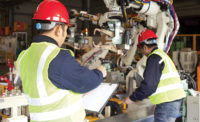A slice of safety

No matter what industry you work in, most companies open corrugated boxes - whether it is to get parts, ingredients or items for stocking shelves. This task is such a basic part of all operations that the risks involved can be overlooked easily and employers could fail to consider the impact it could have on their organization. Using the right tool to open these boxes can help protect your workers from injuries and save your company money.
When faced with the decision of whether to purchase a standard utility knife or a safety cutter, employers might ask: What is the final cost? What is the true value? The outcome of this decision can end up being measured on the bottom line - increased workers’ compensation and increased medical expenditures.
Attitude adjustment
Many employers say, “We just run down to the hardware store and buy some cutters.” This type of approach is a mistake that could have a significant negative impact on a company. What type of impact are we talking about?
A utility knife designed for heavy industrial use with maximum blade length can, in some cases, violate a company’s “Deadly Weaponry” policy. Not only has the company purchased an unsafe utility knife, but it has also paid extra retail dollars when a safety cutter can be acquired on a direct cost-based purchase. Workers using a utility knife can suffer cut injuries, resulting in medical and workers’ compensation costs. A utility knife can also damage products when workers are opening boxes, which can increase shrink rates. Another added risk: employees can get into a car accident, injuring themselves or others, during the purchasing process of “running to the hardware store.”
Protect workers & products
Safety cutters are designed to protect both the user and the contents of the box they are opening. Many different types of safety cutters are available. Consider purchasing one with a guard that cannot be overridden or bypassed. Production rates can increase, as employees are confident knowing they are protected. The blade is angled upward so as not to damage the inside contents of the box, so shrink rates go down. Safety cutter per unit prices are lower than paying retail pricing along with the replacement blades that will be needed.
Final verdict on value
What is the true value of purchasing a safety cutter? Recap for yourself using your organization’s numbers: lower workers’ compensation costs and rates, lower medical costs, reduced shrink rates, lower purchase costs, and no employee car accident lawsuits. Safe vs. unsafe - safe wins.
Looking for a reprint of this article?
From high-res PDFs to custom plaques, order your copy today!




